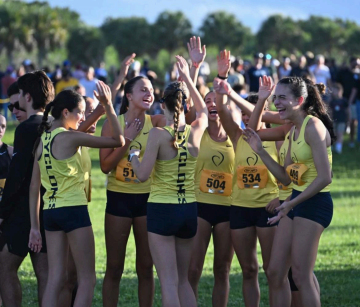About a month ago, two out of the three Australian pine trees along the sidewalk between our two Carrollton campuses had removal notices posted on them. According to a Miami-Dade County Tree Impact report, the tree removal is called for when there are “poor conditions, nearby construction, or safety conditions.” All three trees are 100 years old and have dead limbs and decreased foliage. They are not thriving and pose a threat to passers by.
But why only two of the three trees? According to neighbors on Devon Road these trees evidently “interrupt their view of speeding traffic,” but isn’t that a problem everywhere in the Grove?
So should these two trees be removed so that neighbors have a better view when exiting onto Main Highway or should all three of the trees be removed because they are a danger to people passing by on the sidewalk?
Australian Pine Trees are native to Southeast Asia and Australia and were brought to Florida in the late 1800’s. They do not hold well in hurricanes. In fact, prior to Hurricane Andrew in 1992, Bill Baggs Park at the tip of Key Biscayne was populated with Australian Pines, and with the storm they all went down. While Australian Pines, like other trees, provide shade, remove CO2 from the atmosphere, and produce oxygen, they also choke out native vegetation which in turn reduces food and habitat for native insects, birds, and animals. According to the Everglades Cooperative Invasive Species Management, they grow quickly and have shallow roots that contribute to beach erosion.
The importance of trees cannot be underestimated, and with widespread Miami development, trees are being removed at an alarming rate. Currently, the penalty for removing a native tree in Coconut Grove is between $500 – $10,000.
There are several organizations which are working to raise awareness about the importance of native trees and one is FIU’S Grove ReLeaf. “The purpose for this organization focuses on teaching plant identification and inventory skills while also developing a citizen science network for urban tree mapping and monitoring across the Miami area,” said principal investigator of the organization, Christopher Barloto. This organization has successfully added over 2,000 trees to their inventory list and is expected to double that number within the next year. If the trees are removed, Grove ReLeaf could certainly make recommendations for replacement trees which would not interfere with drivers’ line of sight and provide all the benefits of native trees to the environment.
Junior high students, under the direction of 7th grade science teacher Mrs.Thome, have been working closely with Grove ReLeaf, a program facilitated by the International Center for Tropical Botany. They have been cataloging the trees on both Carrollton campuses including name, breadth, estimated water consumption and the shade they produce. “Students are gaining a window into how decisions in a community are made through their participation in the program. Better informed citizens make better decisions about their community,” said Mrs. Thome. This collaboration is educational to Carrollton students, but it also provides important information for our policy makers. “I always wanted to serve the earth, I love the idea that we can save the trees from our own classroom. I think it’s really cool that everyone can take part in this project to save the trees, and help the environment as a whole,” said Ava Jones ‘27.







































